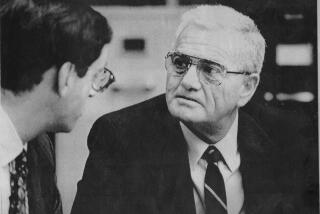‘Nova’ honors scientist
- Share via
In April 1953, British scientists James Watson and Francis Crick discovered the double helix structure of DNA, the molecule considered a blueprint of life. They went on to share in a Nobel Prize. But biologist Rosalind Franklin was an unknowing collaborator in their work, her role obscured by maneuvers undertaken behind her back and downplayed in most accounts.
Fifty years later, “Nova” tries to give Franklin her due in “Secret of Photo 51” (8 p.m., KCET), an intriguing and suspenseful account of the race to untangle the mystery of DNA. One warning, however: This show requires close viewing or it can be tough to follow, especially for those of us who think double helix refers to a figure skating move.
Franklin died of cancer in 1958 at age 37, unaware that Watson and Crick had seen a key piece of her data -- the X-ray image she labeled “Photo 51” -- without her permission and that it helped spark their insight.
The program draws on interviews with surviving players in the DNA drama, including Maurice Wilkins, a bigwig at the lab where Franklin worked, who casually showed the photo to Watson and went on to share in the 1962 Nobel. Brenda Maddox -- whose ironically titled biography, “Rosalind Franklin: The Dark Lady of DNA,” serves as source material -- weighs in too.
Born into a prominent Jewish family in London in 1920, Franklin was a math whiz who faced gender barriers in her pursuit of a scientific career. She became a leading expert in X-ray crystallography and took a post at a London college to study the structure of DNA with Wilkins, but the two disliked each other and worked separately. The exacting Franklin discovered two forms of DNA and made detailed X-rays of them; her Photo 51, which took 100 hours of exposure, was exceptional.
Wilkins casually showed the image to Watson, who was unofficially working on the DNA puzzle with Crick at another lab. “My mouth fell open and my pulse began to race,” Watson wrote in his memoir, “The Double Helix,” which portrayed Franklin as evil and clueless. The photo proclaimed that the structure had to be a helix.
Oddly enough, had she lived, Franklin might not have minded being slighted and may not have wanted all the fuss, according to Maddox and others. She was all about the science.






